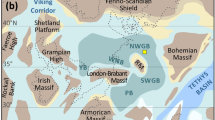Abstract
In the summer 2006, integrated geological, geochemical, hydrological, and hydrochemical studies were performed on the relict anoxic Lake Mogil’noe (down to 16 m depths) located on Kil’din Island in the Barents Sea. The chemical and grain-size composition of the bottom sediments were compared for the lake (a permanently anoxic basin) and the Baltic Sea Deeps (periodically anoxic basins). The vertical location of the hydrogen sulfide layer boundary in the lake (9–11 m depths) was practically the same from 1974 up to now. The concentrations of suspended particulate matter in the lake in June and July 2006 appeared to be close to its summer concentrations in the seawaters of the open part of the Baltic Sea. The mud from Lake Mogil’noe compared to those of the Baltic Sea Deeps are characterized by fluid and flake consistency and by pronounced admixtures of sandy and silty fractions probably of eolic origin. The lacustrine mud contain much plant remains; iron sulfides and vivanite were also found in ooze. The concentrations of 22 elements determined in the lacustrine bottom sediments were of the same levels as those found here 33 years ago. The concentrations also appeared to be close to those in the corresponding grain-size types of the bottom sediments in the Baltic Sea. The low Corg/N value (5% on average) in the mud of Mogil’noe Lake compared to the values for the mud of the Baltic Sea Deeps (10% on average) points to the considerable planktogenic component in the organic matter composition of the lacustrine mud. No indications were reveled for anthropogenic contaminations of the lacustrine bottom sediments with toxic metals.
Similar content being viewed by others
References
P. L. Bezrukov and A. P. Lisitsyn, “Classification of Sediments of Modern Marine Basins) Tr. Inst. Okeanol. Akad. Nauk SSSR 32, 45–78 (1960).
K. M. Deryugin, “Relict Lake Mogilnoe (Island Kil’din in the Barents Sea),” Tr. Petergof. Estestv.-Nauchn. Inst., No. 2, 23–45 (1925).
E. M. Emel’yanov, Sedimentogenesis in the Atlantic Ocean Basin (Nauka, Moscow, 1982) [in Russian].
E. M. Emel’yanov, “Barrier Zones in the Ocean. Sedimentation and Ore Formation,” in Geoecology (Yantarnyi Skaz, Kaliningrad, 1998).
E. M. Emel’yanov, “Mineralogy of Sandy-Alevrite Fractions of Modern Sediments of the Mediterranean,” Litol. Polez. Iskop., No. 2, 3–21 (1968).
E. M. Emel’yanov, “Geochemistry of Suspensions and Sediments in the Gdansk Basin and Sedimentation Processes,” in Geochemistry of Sedimentogenesis in the Baltic Sea (Nauka, Moscow, 1986), pp. 57–114 [in Russian].
E. M. Emel’yanov and V. A. Kravtsov, “Cause of Elevated As Concentrations in the Baltic Sea and Vistula Lagoon,” Geokhimiya, No. 8, 798–815 (2007) [Geochem. Int. 45 (8), 798–815 (2007)].
V. P. Petelin, “New Method of Water Mechanical Analysis of Marine Bottom Sediments,” Okeanologiya 1(1), 143–148 (1961).
V. P. Petelin, Particle-Size Analysis of Marine Bottom Sediments (Nauka, Moscow, 1967) [in Russian].
N. G. Prokoptsev, “Method of Mechanical Analysis of Pelitic Fractions of Marine Bottom Sediments (Suspension Balances),” Okeanologiya 4(4), 699–707 (1964).
Relic Lake Mogil’noe, Ed. by V. I. Gurevich and Z. Ya. Tseeb (Nauka, Leningrad, 1975) [in Russian].
Management of Quality of Analytic Work. Classification of Methods of Analysis of Mineral Resource by the Accuracy of Results, OST 41-08-212-82 (VIMS, Moscow, 1982), p. 86 [in Russian].
E. M. Emelyanov, V. A. Kravtsov, N. G. Kudryavtsev, et al., “Materials and Methods of Research,” in Geology of the Gdansk Basin (Baltic Sea) (Yantarny Skaz, Kaliningrad, 2002), pp. 13-25.
E. M. Emelyanov, Baltic Sea: Geology, Geochemistry, Paleoceanography, and Pollution (Yantarny Skaz, Kaliningrad, 1995).
E. M. Emelyanov, “Biogenic Components and Elements of the Central Baltic and Their Redistribution,” Mar. Geol. 172(12), 23–41 (2001).
E. M. Emelyanov, Barrier Zones in the Ocean (Springer, Heidelberg, 2005).
Author information
Authors and Affiliations
Corresponding author
Additional information
Original Russian Text © E.M. Emel’yanov, V.A. Kravtsov, G.A. Tarasov, 2010, published in Okeanologiya, 2010, Vol. 50, No. 3, pp. 440–457.
Rights and permissions
About this article
Cite this article
Emel’yanov, E.M., Kravtsov, V.A. & Tarasov, G.A. The key features of the bottom sediment composition in the anoxic Lake Mogil’noe. Oceanology 50, 408–424 (2010). https://doi.org/10.1134/S0001437010030100
Received:
Accepted:
Published:
Issue Date:
DOI: https://doi.org/10.1134/S0001437010030100




